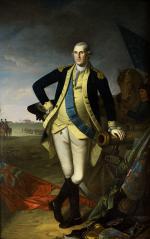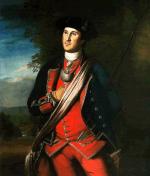![header=[Marker Text] body=[July 9, 1755, Gen. Braddock's British forces en route to capture Fort Duquesne were ambushed and routed by French and Indians within present limits of Braddock and North Braddock, forcing retreat and failure of the expedition.] sign](http://explorepahistory.com/kora/files/1/10/1-A-21A-139-ExplorePAHistory-a0h5c3-a_450.jpg)
Mouse over for marker text
Name:
Braddock's Defeat
Region:
Pittsburgh Region
County:
Allegheny
Marker Location:
Jones Avenue, east side, North Braddock
Dedication Date:
April 28, 1948
Behind the Marker
General Edward Braddock was anxious to get moving in June 1755. He had arrived in North America several months earlier with an army of British regulars and orders to dislodge the French from the Forks of the Ohio, where they had built Fort Duquesne. For an old soldier like Braddock, America was a very frustrating place. Colonial Americans, rather than being grateful for the protection of his army, dragged their feet in providing support for his expedition.
Rather than cooperation, the colonial governments offered Braddock only a tangled mess of competing interests and advice. Transporting a large army through the American wilderness was another headache altogether. Braddock could use the Potomac River as a route west only as far as Fort Cumberland, Maryland; from there, he would have to cut a road through the wilderness to Fort Duquesne.
So it was probably with some impatience that Braddock heard speeches from Indians at Fort Cumberland just before he launched his army on its overland route. Everyone told him that Indian allies were indispensable in American warfare, but so far, all Braddock could tell was that Indian diplomacy took forever to conduct, probably because the Indians used it as an excuse to consume provisions and supplies intended for his troops. The last straw came when Shingas, a Delaware chief from the Ohio Country, asked Braddock for a guarantee that the British would vacate the Forks of the Ohio once the French were removed. In reply, Braddock made it quite clear that he was going to the Ohio Country to secure that land for the British king, and he would remain there as long as the king ordered him to do so.
When Shingas and his fellow Delaware expressed misgivings about these plans, Braddock told them that he had "no doubt of driving the French and their Indians away" even without their help. Braddock felt the full impact of his haughty rejection of his potential Indian allies several weeks later. The French and Indian War began in earnest on the Pennsylvania frontier on July 9, 1755, when a combined French and Indian force defeated Braddock's army near Fort Duquesne.
French and Indian force defeated Braddock's army near Fort Duquesne.
Shortly after dismissing all but a handful of Indians, Braddock left Maryland with an army of 2,500 men to lay siege to Fort Duquesne at the Forks of the Ohio. In an effort to speed his progress, Braddock formed a flying column of 1,500 men that could move ahead of the support column by traveling without heavy baggage. On the morning of July 9, Braddock and the flying column crossed the Monongahela River and moved within ten miles of Fort Duquesne. They proceeded confidently, right into a French and Indian force that decimated their ranks. Two-thirds of Braddock's flying column were killed or wounded that afternoon.
The well-trained British regulars tried to form ranks and return the enemy's fire, but so many of their officers were killed that confusion reigned. The American militiamen were less disciplined and broke ranks quickly, retreating in a pell-mell fashion that resulted in some being killed by volleys of fire returned from the British regulars. George Washington, a young Virginian militia officer serving as Braddock's aide-de-camp, had two horses shot out from underneath him, and four bullets passed through his clothing. Braddock himself stayed in the saddle in the heat of the battle, trying to rally his troops until he was wounded in the side.
George Washington, a young Virginian militia officer serving as Braddock's aide-de-camp, had two horses shot out from underneath him, and four bullets passed through his clothing. Braddock himself stayed in the saddle in the heat of the battle, trying to rally his troops until he was wounded in the side.
Braddock died of his wound a few days later as the remnant of his force retreated to Fort Cumberland. The surviving officers buried his body in the road that bore his name and then ordered the retreating soldiers to walk over it, so that the French and their Indian allies would not be able to find the grave.
His army's abandonment of the campaign left the Pennsylvania frontier exposed to French and Indian war parties supplied from Fort Duquesne. The western Delaware and other Ohio Indians who were inclined to ally with the British found themselves without any means of support other than the French. In the following months, many of them joined with the French in raids against colonial settlements along the Pennsylvania frontier, destroying the peace that had existed in the colony's Indian relations since its founding in 1682.
Rather than cooperation, the colonial governments offered Braddock only a tangled mess of competing interests and advice. Transporting a large army through the American wilderness was another headache altogether. Braddock could use the Potomac River as a route west only as far as Fort Cumberland, Maryland; from there, he would have to cut a road through the wilderness to Fort Duquesne.
So it was probably with some impatience that Braddock heard speeches from Indians at Fort Cumberland just before he launched his army on its overland route. Everyone told him that Indian allies were indispensable in American warfare, but so far, all Braddock could tell was that Indian diplomacy took forever to conduct, probably because the Indians used it as an excuse to consume provisions and supplies intended for his troops. The last straw came when Shingas, a Delaware chief from the Ohio Country, asked Braddock for a guarantee that the British would vacate the Forks of the Ohio once the French were removed. In reply, Braddock made it quite clear that he was going to the Ohio Country to secure that land for the British king, and he would remain there as long as the king ordered him to do so.
When Shingas and his fellow Delaware expressed misgivings about these plans, Braddock told them that he had "no doubt of driving the French and their Indians away" even without their help. Braddock felt the full impact of his haughty rejection of his potential Indian allies several weeks later. The French and Indian War began in earnest on the Pennsylvania frontier on July 9, 1755, when a combined
Shortly after dismissing all but a handful of Indians, Braddock left Maryland with an army of 2,500 men to lay siege to Fort Duquesne at the Forks of the Ohio. In an effort to speed his progress, Braddock formed a flying column of 1,500 men that could move ahead of the support column by traveling without heavy baggage. On the morning of July 9, Braddock and the flying column crossed the Monongahela River and moved within ten miles of Fort Duquesne. They proceeded confidently, right into a French and Indian force that decimated their ranks. Two-thirds of Braddock's flying column were killed or wounded that afternoon.
The well-trained British regulars tried to form ranks and return the enemy's fire, but so many of their officers were killed that confusion reigned. The American militiamen were less disciplined and broke ranks quickly, retreating in a pell-mell fashion that resulted in some being killed by volleys of fire returned from the British regulars.
Braddock died of his wound a few days later as the remnant of his force retreated to Fort Cumberland. The surviving officers buried his body in the road that bore his name and then ordered the retreating soldiers to walk over it, so that the French and their Indian allies would not be able to find the grave.
His army's abandonment of the campaign left the Pennsylvania frontier exposed to French and Indian war parties supplied from Fort Duquesne. The western Delaware and other Ohio Indians who were inclined to ally with the British found themselves without any means of support other than the French. In the following months, many of them joined with the French in raids against colonial settlements along the Pennsylvania frontier, destroying the peace that had existed in the colony's Indian relations since its founding in 1682.










